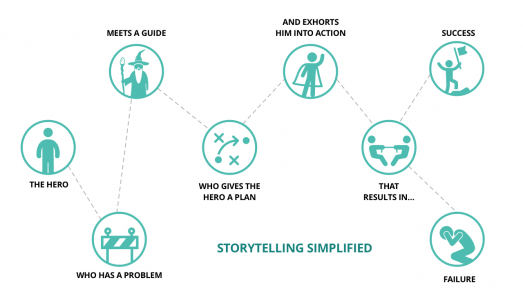I had written earlier about how to use research to understand pains and problems of your customers.
Following that exercise, we need to piece together the messaging for websites and landing pages.
The caveat for messaging is that it needs to sell to the audience. Sell needs to transform the customer's experience of pain.
Is there a tried, tested and proven framework for selling online?
Well there are many. For starters, check out Joanna Weibe's excellent compendium of Copy Forumlas here.
I recently came across Donald Miller’s StoryBrand technique for creating and clarifying the sell message on websites.
Donald Miller says he has studied several Hollywood Blockbusters. He has then essenced the success framework of the hit movies into a story telling framework.
He uses the success formula to sell brands on the web. The result is clarity in messaging and all the ingredients needed for persuading the customer to buy immediately.
The True Origins of the StoryBrand Formula
The StoryBrand formula itself is a mix of several formulas, in my view. Let me explain.
The first is The Hero With A Thousand Faces by Joseph Campbell.
This book, written in 1949, used insights from psychology to unravel the structure of ancient myths across the world. Joseph Campbell then deconstructs the myths into an elegant Hero's Journey Formula.

Many Hollywood blockbusters are based on the Hero's Journey principles outlined by Joesph Campbell.
Watch Chris Vogler's explanation of the Hero's Journey as applied to Hollywood movies: https://www.youtube.com/watch?v=7ZzeTuFen9E
So essentially, the StoryBrand formula is derived from Joseph Campbell's storytelling formula and its origins in universal mythology.
But the resonance doesn't end there.
In my view, StoryBrand is also an update on copywriting formulas: Ray Edwards's PASTOR and many others.
So in essence, there are many copywriting formulas. You can learn one and study the nuances of the others with respect to the one you know.
You can also reverse engineer, or study the structure of the copy that happens on websites. I have explained this later in this article.
StoryBrand is just one more copy formula at its core.
But it's a well marketed one. It's also useful. It gives you a quick structure for copy.
Not the precise messaging, though. For that you need to read the great ads of the direct response copywriters.
Two, copy can only convert folks who visit your website.
To make copywriting go farther, you need to envelope it with an extended product. This covers the acquire and nurture sequences in Digital Marketing.
Nurture uses buying funnels to capture prospect capture propsects using Lead Magnets. Then nurtures leads using autoresponders with email sequences.
Acquire uses techniques of SEO, PPC, Social Ads, Affiliate Marketing, etc, to bring traffic to the website.
With that background, let's try and understand the StoryBrand Copy Formula.
The 7-point StoryBrand framework by Donald Miller
- A character, usually the hero/ or your customer
- With a problem/pain/ need
- Meets a Guide/ Mentor [the brand]
- Who gives the hero a plan [precise steps to achieve a goal]
- That calls them to action
- That results in Tragedy [failure]
- or Comedy [success]
You can view the brandscript framework on the StoryBrand website
The template for writing the StoryBrand brandscript is publicly available here.

Once you understand the pains and problems of your audience you can use the StoryBrand framework to write the brandscript.
There are a few nuances to the StoryBrand script.
The character's problem has 3 levels: Internal/ External/ Philosophical.
You need to understand and address all three problem levels to get a winning message.
The Guide has two qualities that need to be demonstrated to the customer to be credible:
Empathy [I have been in your shoes], and the Authority [I have solved that problem and more].
The plan needs to be precise [the number of steps] and graspable.
Eg 3 easy steps to financial freedom. Not 17 steps.
There are two aspects to the Call to Action:
> It can be direct [buy now, schedule an appointment, dwonload free trial] or
> Transitional [Download this eBook, View this Video. It interests/ captures the prospect.]
Success is the transformation of the pain experience for the customer.
If you can get into the customer's head and weave vivid imagery around how he/she will be tranformed with the use of the product or service, you'll be home.
Tragedy is about the stakes in the game for the customer.
According to Donald Miller, without the stakes, there is no story. Stakes provide the contrast: trafedy vs success, and accentuates the success.
Remember to write to the StoryBrand principles for each audience that you wish to target, separately.
Michael Lukaszewski shares with us what he learned at the StoryBrand Workshop with Donald Miller. This offers some great insights into how StoryBrand works.
Search for the StoryBrand Brandscript on Google
A simple search on Google Images for “StoryBrand brandscript” gives us some more details.
- The framework for writing the StoryBrand brandscript
- Several fleshed out brandscripts written for some brands
- A search for StoryBrand Website examples will unearth websites written with this copy formula. Observe the structure and then the content flow in each website.
You will notice that the techniques for writing web copy is very similar to Ray Edward’s PASTOR rule.
In fact, what we learned is that if you mix some of the elements of PASTOR with Donald Miller’s StoryBrand, you will end up with a fairly compelling copy.
By the way, Donald Miller and Ray Edwards are collaborators in videos and podcasts.
Ray Edwards' PASTOR Principles of Copywriting
P - your customer’s pain/ problem/ need
A - amplify the pain. You need to amplify to contrast and register the pain.
S - your story/ solution to the pain
T - transformation and testimony, social proof that reinforces the credibility of your communications
O - offer that could be a price offer
R - the response that you want from he customer
We have written copy for several websites that follow the PASTOR framework and can swear that it works.
Are the websites using StoryBrand different from those using the PASTOR framework?
Donald Miller tells us that tragedy creates tension in the story. Without tragedy, there is no story. So tragedy is an integral part of story telling.
In PASTOR: Pain and Amplification of Pain provides the same contrast to the solution as tragedy does in StoryBrand.
Apart from the Value Proposition [the unique benefits your brand offers] and the Agreement [the guarantees that go with your service], there is hardly any difference, in my view.
In terms of telling a story for a brand, the tragedy translates into:
- “what would happen if you did not buy this brand?”
- “what would happen if you put up with the status quo?”.
If you see examples of StoryBrand websites, or PASTOR copy-based websites, or any of the copy framework driven websites, you will notice these techniques at play.
Some of the Copy Formula Driven Websites that convert.
- D'frens
- Joshua Royalties
- ANI Integrated Services
- Village International Education, Thailand
- Zingformation NLP Services
- ISET AI & ML Course
- Bay Tech 360
- Modern Properties
Where can you use StoryBrand, or PASTOR, or any Copy Framework?
Use any of the copy frameworks/ formulas, described in this article, to create:
- Website messaging for your money pages
- Landing Pages for PPC, FB Ads
- Messaging for Marketing Collaterals
- Writing Blog Posts that follow a clear structure
- Social Media Posts
- Emails: Cold Emails, Onboarding Emails, Newsletters
How to build your Copy Message
Start with the insights and motivation you have on your customers for this.
Write the story using the logic given below.
Check for examples of sites that use the copy frameworks.
Glean how copywriting transforms customer insights into a value stack for the story.
If you analyze websites that sell well, this is the structure you will mostly see.
- Value Proposition with at least 3 support points
- Tragedy or Pain with Amplication of the Pain to contrast it with the solution that follows
- Your Solution or Success for your Customer
- Social Proof [Testimonials, Case Studies, Accreditations, Awards - these are generously sprinkled in the copy flow]
- Calls To Action [you need this virtually on every panel to get the customer who's conveinced to enquire at point along the persuasion continuum]
- Pricing or Offer [contrasted with the pain that the solution resolves]
- How to buy from you [the exact steps that make it easy for the customer to buy from you]
- The terms/ benefits of buying from you [Or why should someone buy your brand as opposed to another brand, product/ benefit comparisons with competitors]
- FAQs [Answers to frequently asked questions, or common objections dealt with]
The elements of this structure are not fixed. It can appear differently on different websites.
The study of good websites gives you a deeper understanding of what is happening in it. How the sell is constructed using copy.
With a few tries you can do this too.
But remember, expert copywriters will be able to do it faster and with a better sell.
If you need help with writing using expert copywriting for your website, landing page, or marketing collateral messages, write to Pigtail Pundits.
Do Read: How to hire a StoryBrand Copywriter to Sell on Your Website and Landing Pages.
Do you need any certification to write good copy?
Well, if you ask me, nope. Copy frameworks are but structures. Many exist.
It would be quite a stretch to imagine that one formula, such as PASTOR, or for that matter StoryBrand, can solve all the selling problems that we have.
I sense a danger in evangelizing just one framework. As someone said, if the only tool in your box is a hammer then all problems will start to look like nails.
You need to experiment with multiple formulas to arrive at what works for you best.
While frameworks offer a great shortcut to peg your copy on, it's not the ultimate solution for all selling.
As we learn more about how humans buy, through advances in neurocience, behavior design, and psychology, our copy frameworks and messaging within it will get better.
I am not StoryBrand Certified.
But can I write copy? Sure I can. So can a whole bunch of folks who have been trained in, or have studied, direct response copywriting techniques,
Let's also understand that there is little originality in ideas that we use today.
We beg, borrow and steal to make what looks like a new idea. We then hurry to apply copyrights to it.
Let's take an example here to illustrate this malaise.
Suppose you build a movie based on a famous framework say, Joseph Campbell's.
I come in later, and reverse engineer the success of the movie using what I call a propietary formula.
Is not the second formula derived from the original formula, then?
Do you own the copyright then? Or do I, the reverse engineer, own the rights to the derived framework?
Are there proven storytelling frameworks that you can use for web copy?
We’re always looking to hone our craft.



